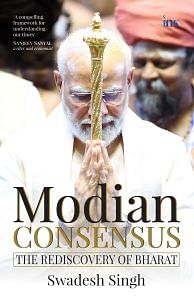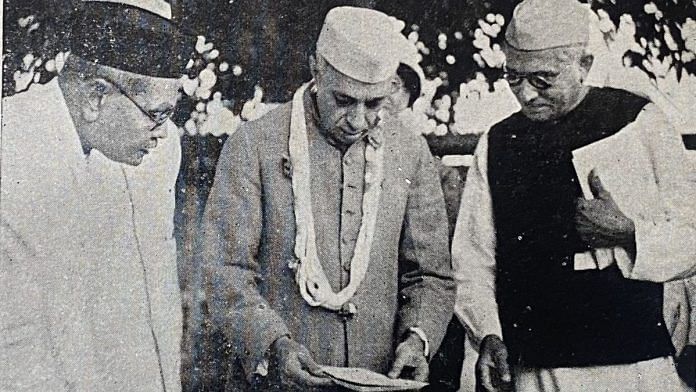The Nehruvian Consensus which moved the Indian nation-state for almost 40 years, shattered and demolished the ideas of the Civilisational Consensus and the Gandhian Consensus both of which had spiritualism and the Indian civilisational value system at their core. The nouveau values of the Nehruvian Consensus were popularised by the ruling class, their followers and the intelligentsia of the time to maintain hegemony.11 Nehru himself believed in the socialist and secular value system and tried to propagate it through the educational and cultural realms by appointing people with similar understanding. His daughter continued this tradition. A glance at the education ministers— the ministry also used to include the culture department—reveals a distinct pattern that many find astonishing, even unbelievable. It is hard to imagine how immediately after the Partition, most of the education ministers were from the community that singularly supported it. It seems this was an organised effort to establish an educational system that did not hold the ancient civilisational values of India in high esteem and also made young minds doubt their core value system. After independence, there was a dire need to build a new system based on the values of Indian civilisation through education and culture; but, at that point, the mantle was not given to the people who had a deep understanding of the Indian educational and cultural system.
Characteristics of the Nehruvian Consensus
The Nehruvian Consensus propagated the ideals of socialism, secularism and non-alignment that manifested in every aspect of Indian life and institutions. Nehru kept himself away from religion and claimed to be a humanist. He wrote, The spectacle of what is called religion, or at any rate organised religion, in India and elsewhere, has filled me with horror and I have frequently condemned it and wished to make a clean sweep of it. Almost always it seemed to stand for blind belief and reaction, dogma and bigotry, superstition, exploitation and the preservation of vested interests.
The idea of secularism propagated under the Nehruvian Consensus essentially turned into the politics of Muslim appeasement. The concept of composite culture was aggressively propagated culminating in a whitewashed and revisionist view of India’s history. Now, every Indian had to accept the Mughal past as their own and celebrate its contributions, turning a blind eye towards the horrors often associated with Islamic invasions. Given that the nation had just come out of a blood-ridden Partition and the new state of Pakistan—created in the name of Islam—had attacked thrice in 23 years (1948, 1965, 1971), this was a difficult pill to swallow.
In any case, the academic curriculum was manoeuvred to showcase the medieval period in a positive light. On the other hand, the ancient period—when most of the Indian literature was written and arts, culture and science flourished—was deliberately sidelined. The sultans of Delhi were portrayed as the emperors of India though there were many big and independent states flourishing in different parts of India at the same time. During Indira Gandhi’s tenure, the All India Muslim Personal Law Board was set up in 1972 and many relaxations were given to Muslims in different states. The protection of minority rights as enshrined in the Indian Constitution was converted into the politics of Muslim appeasement. Nehru had a great penchant for international relations. Despite this, India did not get international support when it needed the most. Nehru committed strategic errors while following the policy of non-alignment which is considered a vital pillar of the Nehruvian Consensus. When the simplest route to resolve the Kashmir issue could have been either the use of military force or bilateral talks, he dragged the issue to the United Nations (UN), an organisation which, at that point, was still in a nascent stage and yet to acquire the kind of legitimacy it commands today. There are still certain sections which defend Nehru’s move saying that if India had not approached the UN on the Kashmir issue, then Pakistan would have gone forward with it. However, this is a fallacious argument as Pakistan was the aggressor in Kashmir, and it was highly unlikely for Pakistan to approach the UN. Nehru was convinced by Lord Mountbatten that it was right to refer Kashmir to the UN.
The support of both—the capitalist and socialist—blocs was lost in the wake of the non-aligned stand of Nehru. He did not accept the permanent membership of the United Nations Security Council when it was offered to India. Nepal was ready to become a part of India, but that too Nehru did not accept.
Socialism was the third pillar of the Nehruvian Consensus. On the one hand, Nehru declared India to be a non-aligned country, and on the other, the Congress passed a resolution of ‘Socialist Pattern of Society’. However, when the need arose during the war with China, even Soviet Russia did not extend help. This inability to make friends abroad persisted with Indira Gandhi. She signed a strategic treaty with Soviet Russia due to which the USA-led bloc never supported India.
On the ideological front, the leftists were allowed a free hand. The academic curriculum now had a clear stamp of Nehru’s world view reaching every household and classroom. Alternative interpretations of history found a strong footing during this period with historians like Jadunath Sarkar and R.C. Majumdar being shown a backseat. The reins of cultural and civilisational discourse were handed over to historians like Bipan Chandra, Satish Chandra, R.S. Sharma, Irfan Habib, D.N. Jha and Romila Thapar, who portrayed India in a poor light and only bolstered the colonial vestige. These left-leaning historians left no stone unturned to deny India of her past achievements in every field such as arts, literature and science. These historians made it a point to reflect ancient history on the basis of fault lines such as the presence of the caste system. For example, D.N. Jha, in his book Ancient India in Historical Outline, categorically denies that the Gupta Age was the golden period of Indian history. Without any substantial evidence, Jha says that the achievements that Indian society made during the Gupta rule in the fields of arts and sciences were all inspired by the Greeks. Jha wrote that the Gupta Age cannot be considered the Golden Age because of the presence of the caste system. This is one of the many examples of how left-leaning Marxist historians dismissed any achievement of ancient India. On the other hand, these historians had everything positive to write about the establishment of Muslim rule in India. The rulers of the Delhi Sultanate and then the Mughal rulers were glorified in magnanimous proportions. A picture was presented that the Muslim invaders freed India from the ‘Dark Ages’ and were superior in many respects to the ancient Hindu kingdoms. At the same time, these Marxist historians either neglected the independent Hindu kingdoms of the medieval era or mentioned them in just passing reference. Reflection of the Nehruvian Consensus was also seen in cinema, art, culture and theatre. Films like Naya Daur, Awara and Mother India found huge success. India’s poverty was made a subject of dehumanising wonder and was showcased on the big screen by directors like Satyajit Ray. In fact, Nehru was an ardent admirer of Satyajit Ray. It was Satyajit Ray who designed the book cover of Nehru’s Discovery of India. When criticism was levied on Satyajit Ray that he sold Indian poverty under the guise of cinema, Nehru is said to have defended him and even praised his work Pather Panchali for its ‘sympathetic portrayal of poverty’.
This period was also marked by a clear advent of dynasty politics. Nehru became the central figure of this by establishing his daughter Indira in politics. Nehru also appointed his sister Vijaya Lakshmi Pandit ambassador to the Soviet Union and then in quick succession as the envoy to the US, Mexico, Ireland and the UK. With this unfolding right at the top, other politicians too pitched their progeny into politics.
 This excerpt from ‘Modian Consensus’ by Swadesh Singh has been published with permission from BluOne Ink.
This excerpt from ‘Modian Consensus’ by Swadesh Singh has been published with permission from BluOne Ink.




This villainisation of reputed historians like Satish Chandra or Bipan Chandra etc doesn’t make sense. What makes tye RW historians think they aren’t influenced by colonial discourse? The RSS ideology itself is affected by colonial era(for e.g. they deny Aryan migration into India despite even genetic evidence today). And they overglorify Gupta age despite its short comings. “Golden age” concept itself is in a framework of European historiography. And Nehru did the right thing by making Indian question those dubious “civilisational values” or traditions. Any society which doesn’t learn to question itself will fall into Stagnation. This lack of questioning/skepticism of ancients, and villainisation of Musslim heritage, is what plagues RSS led history.